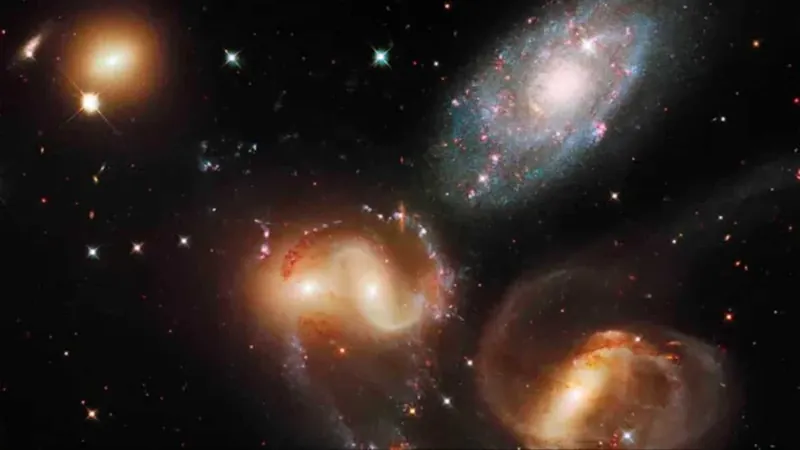
Unveiling the Cosmic Symphony: Universe Records Most Powerful Sonic Booms in Stephan’s Quintet!
2024-11-23
Author: Yu
Abstract
In an astonishing revelation that has captivated the astronomical community, researchers have detected the most powerful sonic booms ever recorded in the universe, stemming from a galaxy hurtling through the cosmos at a staggering speed of 3.2 million km/h (approximately 2 million mph). This explosive event unfolded in the spectacular galactic cluster known as Stephan's Quintet, which comprises five distinct galaxies, each engaged in a breathtaking cosmic ballet.
The Collision in Stephan's Quintet
The galaxy at the center of this cosmic collision, NGC 7318b, collided with the other four galaxies in the Quintet, producing shockwaves that are likened to the sonic booms generated by supersonic jet aircraft. This groundbreaking discovery was detailed in the Monthly Notices of the Royal Astronomical Society on November 22, following observations captured by the William Herschel Telescope Enhanced Area Velocity Explorer (WEAVE) stationed in La Palma, Spain.
Historical Context
Discovered nearly 150 years ago, Stephan’s Quintet has long intrigued astronomers due to its rich tapestry of galactic interactions and remnants from prior cosmic collisions. Marina Arnaudova, lead author and astronomer at the University of Hertfordshire, described the phenomenon, stating, “Since its discovery in 1877, Stephan’s Quintet has captivated astronomers because it represents a galactic crossroad where past collisions between galaxies have left behind a complex field of debris.
The Nature of Shockwaves
The dynamical activity in this galaxy group has been reawakened by NGC 7318b smashing through it at such incredible speeds, leading to shockwaves reminiscent of a sonic boom.”
The nature of the shockwaves generated from this collision was particularly fascinating. As the shockfront traversed through cooler pockets of gas, it exhibited hypersonic speeds that could strip electrons from atoms, creating a luminous trail of ionized gas observable with the advanced WEAVE technology.
Soumyadeep Das, a PhD student involved in the study, elaborated, “As the shock interacts with the surrounding hot gas, it doesn't merely disrupt; it compresses the gas, resulting in radio waves that can be picked up by radio telescopes like the Low-Frequency Array (LOFAR).”
What is Stephan's Quintet?
Stephan's Quintet was first observed by the French astronomer Édouard Stephan in 1877 and is situated approximately 290 million light-years from Earth. This remarkable assembly of five galaxies showcases an ongoing cosmic interaction, where their gravitational ties lead to repeated close encounters, creating a dynamic environment filled with intrigue and scientific potential.
Conclusion
The findings from this research represent a significant step forward in our understanding of cosmic phenomena and the essential role that galactic collisions play in shaping the universe. Scientists are eager to continue investigating the captivating dynamics present in Stephan's Quintet, potentially unlocking more secrets about its history and the complex nature of galactic interactions. Stay tuned, as the cosmos holds endless mysteries waiting to be unveiled!


 Brasil (PT)
Brasil (PT)
 Canada (EN)
Canada (EN)
 Chile (ES)
Chile (ES)
 España (ES)
España (ES)
 France (FR)
France (FR)
 Hong Kong (EN)
Hong Kong (EN)
 Italia (IT)
Italia (IT)
 日本 (JA)
日本 (JA)
 Magyarország (HU)
Magyarország (HU)
 Norge (NO)
Norge (NO)
 Polska (PL)
Polska (PL)
 Schweiz (DE)
Schweiz (DE)
 Singapore (EN)
Singapore (EN)
 Sverige (SV)
Sverige (SV)
 Suomi (FI)
Suomi (FI)
 Türkiye (TR)
Türkiye (TR)